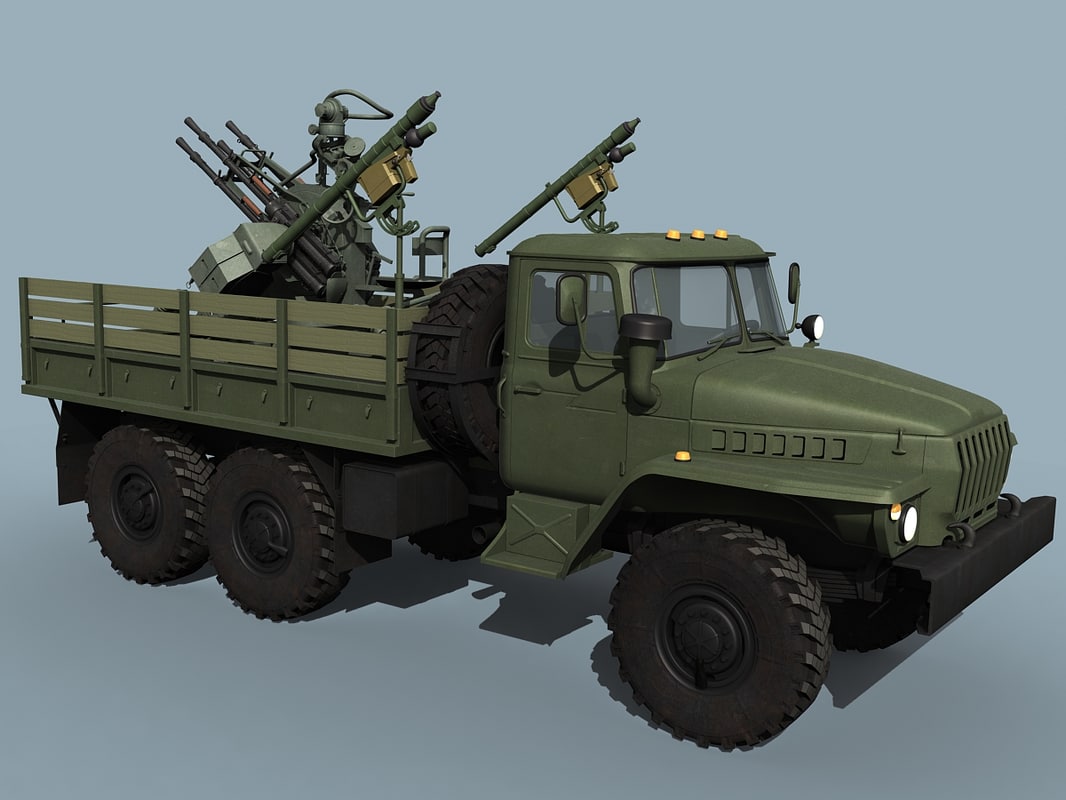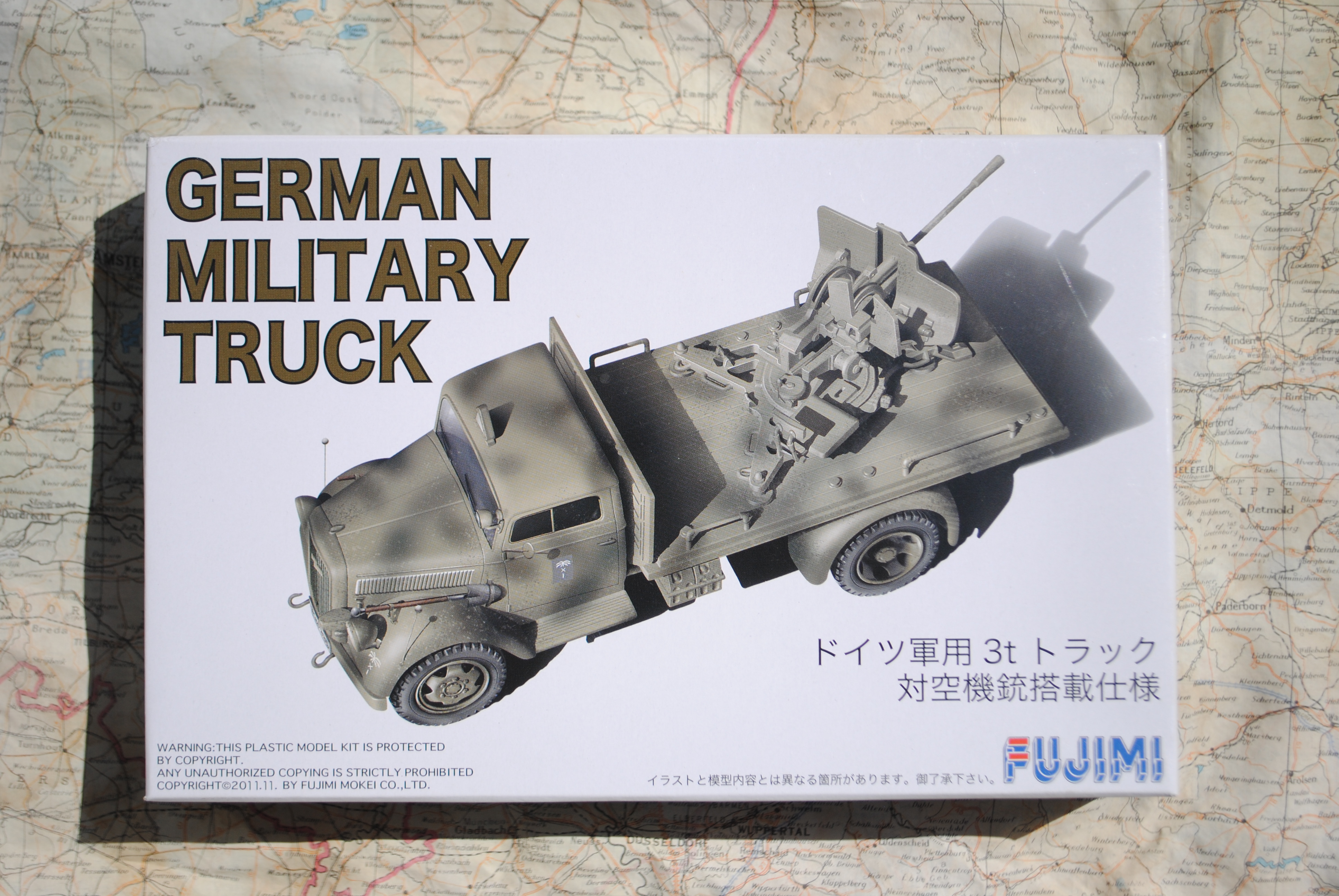Anti Aircraft Truck - The Pancir missile system (Russian: Панцирь, literally “Carapace”) is a family of surface-to-air missile systems and anti-aircraft missiles. Starting with the Pancir-S1 (Russian: Панцирь-S1, NATO reporting name SA-22 Greyhound) as the first model, it was developed by the KBP Instrument Design Bureau of Tula, Russia, and was the successor to the Tunguska M1.
The Pancir-S1 is designed to provide air defense of military, industrial and strategic installations against aircraft, helicopters, precision missiles, naval missiles and unguided vehicles; and provides additional protection for air defense units against enemy air attacks using precision weapons, especially at low to very low altitudes.
Anti Aircraft Truck

It is a short to medium air defense system, mounted, tracked or stationary with two to three crew members. Its air defense consists of automatic anti-aircraft guns and surface-to-air weapons with radar or visual surveillance and radio command guidance.
Russian Self Propelled Anti Aircraft Missile And Cannon System Pantsir S1 Based Editorial Photo
Its purpose is to protect civilian and military areas and targets in the region, for the vehicle or mechanized forces up to the level of the system or as a defense of advanced air defense systems such as the S-300/S-400. The system can carry war. Can hit waterline/above water targets.
It has the ability to work in a completely passive mode. The probability of hitting the target for one weapon is not less than 0.7 with a reaction time of 4-6 seconds. Can fire weapons and weapons while maneuvering.
For its main radar station, detection altitude can be between 0–60° or 26–82° depending on the type of operation.
It is said that this system has great advantages over other systems, such as Crotale NG (France), Roland-3 (France + Germany), Rapier 2000 (UK), SeaRAM (Germany + USA). This is not confirmed by comparative experiments, but clearly follows from the declared limit of system power (2010).
Artistic Forces/gun Truck (mutant Horde)
After receiving a target configuration (from any source) it can measure the target (using all radars except the launch detection radar) in the range -5 to +85 (82)
At first, Soviet missile systems were placed on strong points. Newer systems such as the S-300PS/PM (SA-10/20) are more mobile and less prone to attack. However, when the enemy forces find one S-300, it is still very easy to attack. One of Pancir-S's missions is to provide air defense for the S-300 missile system.
It was decided that a wheeled chassis would be more suitable for the Pancir-S than a fixed chassis, as wheeled vehicles are faster, less prone to damage, easier to maintain and cheaper to manufacture.

Development as the Pancir-S began in the 1990s as an intended successor to the Tunguska M1. The prototype was completed in 1994 and presented at MAKS-1995. The program soon ran into difficulties that led to a financial freeze. However, KBP continued to use its own funds to develop the program. This resulted in the overhaul of both the turret and radar systems and the removal of any aging Tunguska equipment.
Volunteers Raise Funds For 4 Viktor Anti Aircraft Systems
The system has two new high-range radars, which can track air and ground targets. It has an integrated IFF system. Inside the room, two new multifunction LCD displays have replaced most of the CRT screens. A new ctral computer system has reduced reaction time. A single employee can be worked on when needed. Due to the new technology adopted, the total number of weapon stations is reduced by a third, while the total number is reduced by half. This system has upgraded the ammunition (Type 57E6 to Type 57E6-E convertible) and guns (Type 2A72 to Type 2A38M).
A live shooting test was conducted in June 2006 at the Kapustin Yar range, Astrakhan Oblast, Russia. The final phase of the first deployment test in May 2007 at Kapustin Yar included a forced flight of 250 km (160 mi) to an unofficial starting position that ensured the fulfillment of air defense functions.
Russia is developing the Pancir missile system to facilitate the deployment of Russian ground forces and air forces.
This is the first and most model produced from 2008 to 2013, and it is being made for 2019.
International M62 Truck Anti Aircraft Gun Equipped Stock Photo
The new and updated Pancir-S1 model was first presented in February 2019 as one of the expected models. During the development of the new revolution, the experience of setting up the system in Syria is applied.
It has an improved L-band search radar that can track up to 40 targets simultaneously and a new EHF fire control radar that can track up to four targets simultaneously, both with array antennas. The system uses the new 57E6M-E surface-to-air missile with a range of 15 to 18 km (9.3 to 11.2 mi), a range of 20 to 30 km (12 to 19 mi), and a speed of 1,300 . up to 1,700 m/s (4,700 to 6,100 km/h; 2,900 to 3,800 m/h). It has a warhead that weighs 25 kilograms, compared to the 20 warheads of the standard 57E6-E.
A variant of the Pancir-S1 land cruiser was introduced in July 2015. The system uses GSh-6-30K/AO-18KD 30 mm (1.2 in) rotary cannons and six barrels, as seen in Kashtan/Kortik CIWS. , eight missiles instead of 12 and another radar different from the one mounted on the turret itself.

Pancir-M can engage four targets simultaneously with four missiles at a height of 2 to 15 km and a range of 20 km.
Anti Aircraft Missile Launcher
It has several combat modules, including an ammunition supply module in the holder and an under-seat transport system. Surface-to-air missiles from the Pancir-S and Hermis-K defense systems can be used with a firing range of up to 100 km (62 mi).
In the future, it will replace the Kashtan / Kortik CIWS in the warships of the Russian Navy, starting with the Karakurt-class corvettes in 2018.
Modern systems for the Russian military and for export. It includes a new tracking radar, a two-dimensional radar with better features and range. It is the work of Russia and Algeria.
The Pantsir-SM variant includes a multi-role tracking station, increasing target detection from 40 to 75 km (25 to 47 mi) and gagemt from 20 to 40 km (12 to 25 mi).
Ww.ii German 3t 4x2 Cargo Truck / 20mm Anti Aircraft Cannon Flak38 Mounted (2 In 1 Kit) (plastic Model) Package1
The system uses advanced weapons with new colors. Existing Pantsir systems can be upgraded to the SM standard.
It is installed on the chassis of the Kamaz 8 × 8 truck with a military cabin. This development was completed in 2019.
After testing the Pantsir in the Arctic, it was decided to develop a new model specifically for the Arctic, to be used in temperatures below −50 °C (−58 °F) called the Pantsir-SA.

This version does not have the 30mm autocannon installed and is based on the Vityaz armored car. It has been serving in the Russian Northern Fleet since August 2020.
Anti Aircraft Weapon System Truck Stock Photo
The anti-aircraft defense of the Baltic Fleet flew with the Pancir-C1 system as part of a strategic exercise for the air defense unit.
The specification of the Pancir-S1 system is a combination of a multi-band acquisition and monitoring system combined with an integrated rocket and gun armature that creates a continuous gagemta area 5 m (16 ft) high and 200 m (660 ). ft) up to 15 km (9.3 mi) high and 20 km (12 mi) wide, ev without any external support.
The Pancir-S1 carries up to twelve 57E6 (export configuration) 57E6-E (export configuration) two solid surface-to-air missiles with radio/optical guidance in a launch pad, ready to launch. The rocket is arranged in two groups of six tubes in the turret. The weapon has a body with a caliber that has two stages in a tandem configuration. The first stage is the boost, which provides rapid acceleration in the first 2 seconds of the flight, when this is separated from the plane stage.
The carrier is highly maneuverable and has a forward/separation high-explosive warhead, as well as contact and proximity fuses, hot flashes and a radio transponder. The weapon is not equipped with a seeker to cost the target. Instead, weapon tracking is supported by a multi-machine ssor system. Guidance data is provided by radio link for up to four missiles on the aircraft.
Anti Aircraft Defense, Illustration, Vector On White Background. 12263932 Vector Art At Vecteezy
The system is capable of tracking and guiding four missiles fired at four different targets. However, in practice, two rocket salvos are usually fired at each. It is believed that the 57E6 missile can kill 70-90%. They have a shelf life of 15 years in their original sealed container. The Pancir-S1 combat vehicle can fire missiles on the move.
Other rockets, designed to target unmanned aerial vehicles, as well as hypersonic ones, developing speeds greater than Mach 5, have been developed for the Pancir system.
Two twin 2A38M 30 mm (1.2 in) autocannons with 700 rounds of different types of ammunition - HE (High Explosive) for fragmentation, tracer for fragmentation and armor-piercing weapons. The crew can select the type of ammunition based on the type of target. The maximum rate of fire is 2,500 rounds per minute per gun. The length is up to 4 km (2.5 mi). The gun-rocket combination has the ability to engage at high altitude (this system can engage targets up to 0 m AGL).

The wheeled combat vehicle must be raised so that the machine is in a vertical position and the gun can be fired in full. KAMAZ-6560 has four oil hydraulic jacks for this purpose.
Gift For Putin
The fire control system of the Pancir-S1 includes target acquisition
Stinger anti aircraft missile, anti aircraft, anti aircraft missile, anti aircraft artillery, anti aircraft game, anti aircraft gun, aircraft anti collision lights, anti aircraft vehicle, anti-aircraft, anti submarine warfare aircraft, jane fonda anti aircraft, anti aircraft systems
0 Comments